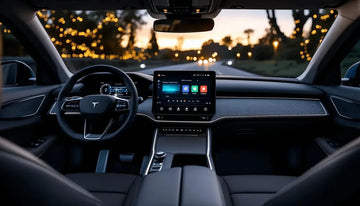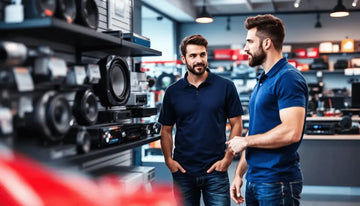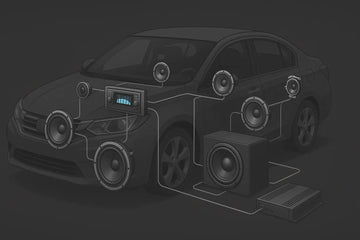Your daily drive doesn’t have to be accompanied by tinny, lifeless sound from factory speakers. Modern automotive audio has transformed the vehicle into a mobile concert hall, offering crystal-clear music reproduction, seamless smartphone integration, and immersive entertainment that can completely transform your journey. Whether you’re commuting to work or embarking on a cross-country road trip, a quality sound system can elevate every moment behind the wheel.
The automotive audio market has experienced remarkable growth, reaching $10.5 billion in 2023 and projected to hit $15.5 billion by 2030. This expansion reflects growing consumer demand for superior audio experiences that match the quality they expect at home. Today’s car audio systems offer far more than basic radio functionality, incorporating advanced technologies like wireless connectivity, voice control, and AI-powered sound enhancement that would have seemed impossible just a decade ago. These innovations continue to push the limits of sound quality and technology, setting new standards for in-car audio performance.
In this comprehensive guide, we’ll explore everything you need to know about modern automotive audio systems, from essential components to cutting-edge technologies, helping you make informed decisions about upgrading your vehicle’s audio system.
What is Automotive Audio and Why Upgrade Your Car’s Sound System?
Automotive audio refers to the complete ecosystem of sound reproduction equipment designed specifically for vehicles, encompassing everything from head units and speakers to amplifiers and digital signal processing. Unlike home audio systems, automotive audio must overcome unique challenges including road noise, irregular cabin shapes, and electrical interference while integrating seamlessly with vehicle safety and navigation systems.
The benefits of upgrading from your vehicle’s stock audio system extend far beyond simply playing music louder. Premium automotive audio systems deliver superior sound quality with balanced frequency response, eliminating the harsh treble and muddy bass that characterize many factory installations. These systems produce clear, detailed sound reproduction that allows you to hear musical nuances you’ve never noticed before.
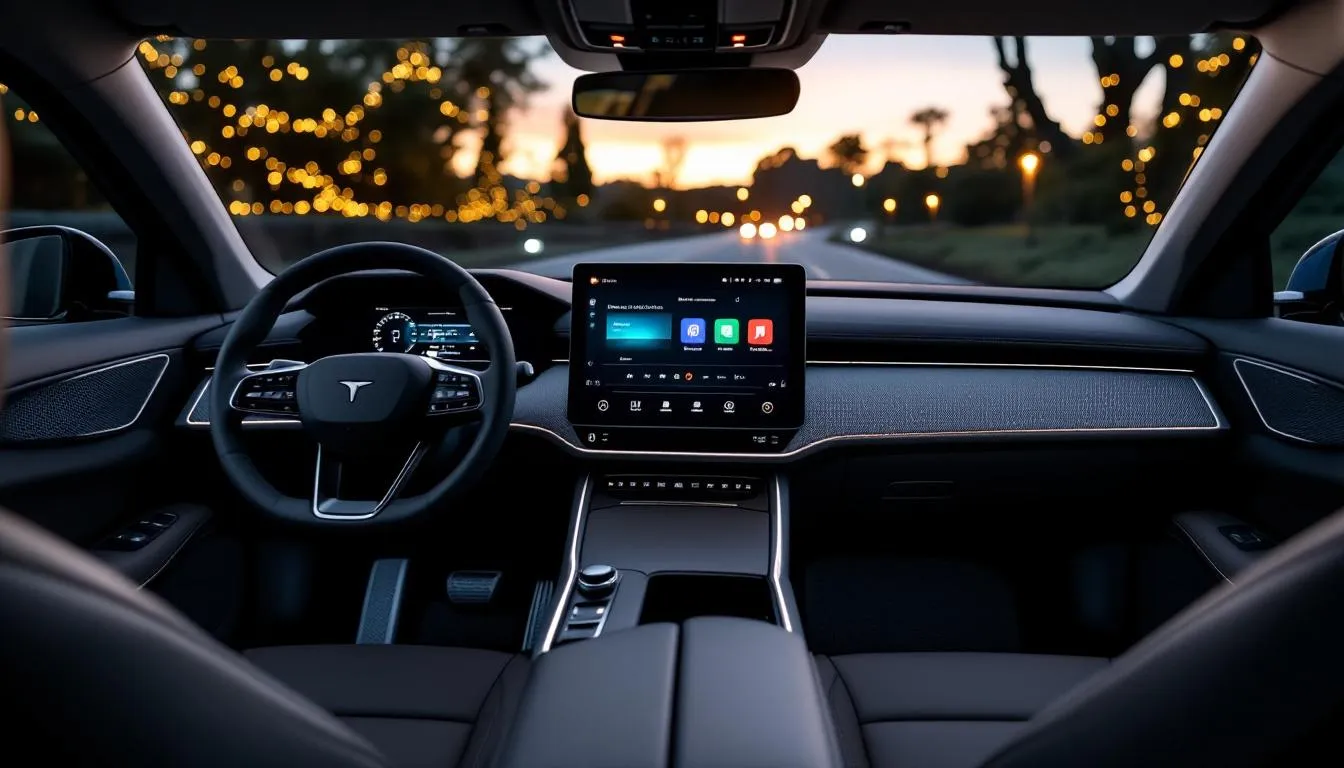
Beyond sound quality improvements, modern car audio systems significantly enhance your driving experience through advanced connectivity features. Wireless Apple CarPlay and Android Auto integration provide seamless access to navigation, music streaming, and communication apps without the hassle of cables. Voice control capabilities let you manage audio settings, make calls, and send messages while keeping your hands on the wheel and eyes on the road.
Upgrading your vehicle’s audio system can also increase its resale value, particularly when professionally installed with quality components. Potential buyers increasingly view premium audio as an important feature, especially in vehicles where they’ll spend considerable time commuting or traveling. A well-designed audio system demonstrates attention to detail and care for the overall ownership experience. Enhancing your ride with a custom audio upgrade not only boosts sound quality but also adds a personal touch of style and enjoyment every time you get behind the wheel.
Modern automotive audio capabilities extend far beyond the basic AM/FM radio that dominated vehicles for decades. Today’s systems integrate streaming services, satellite radio, high-resolution audio playback, and even gaming platforms. Advanced digital signal processing compensates for cabin acoustics, while active noise cancellation reduces unwanted road and engine noise, creating a more comfortable and immersive environment for all occupants.
Essential Components of Modern Car Audio Systems
Understanding the key components of automotive audio systems helps you make informed upgrade decisions and ensures compatibility across all elements. Each component plays a specific role in sound reproduction, and the quality of each directly impacts your overall listening experience.
The head unit serves as the control center for your entire audio system, managing input sources, processing audio signals, and providing the user interface for system operation. Modern multimedia receivers feature touchscreen displays ranging from 6.2 inches to 9 inches, offering intuitive control over audio settings, navigation, and smartphone integration. These units often include built-in amplification for basic installations while providing preamp outputs for external amplifiers in more sophisticated setups.
Speaker systems form the foundation of sound reproduction in your vehicle, and choosing between component and coaxial designs significantly impacts audio quality. Component speakers separate tweeters, woofers, and crossovers into distinct units, allowing optimal placement for superior imaging and soundstage. This design provides audiophile-level performance but requires more complex installation and higher investment. Coaxial speakers combine multiple drivers in a single unit, offering easier installation and cost-effective upgrades over factory speakers while still delivering improved sound quality.
Amplifiers play a crucial role in delivering clean, powerful audio reproduction by providing adequate power to drive speakers effectively. External amplifiers offer superior performance compared to head unit amplification, delivering more power with lower distortion and better dynamic range. Modern Class D amplifiers provide excellent efficiency and compact size, making them ideal for vehicle installations where space and power consumption are important considerations.
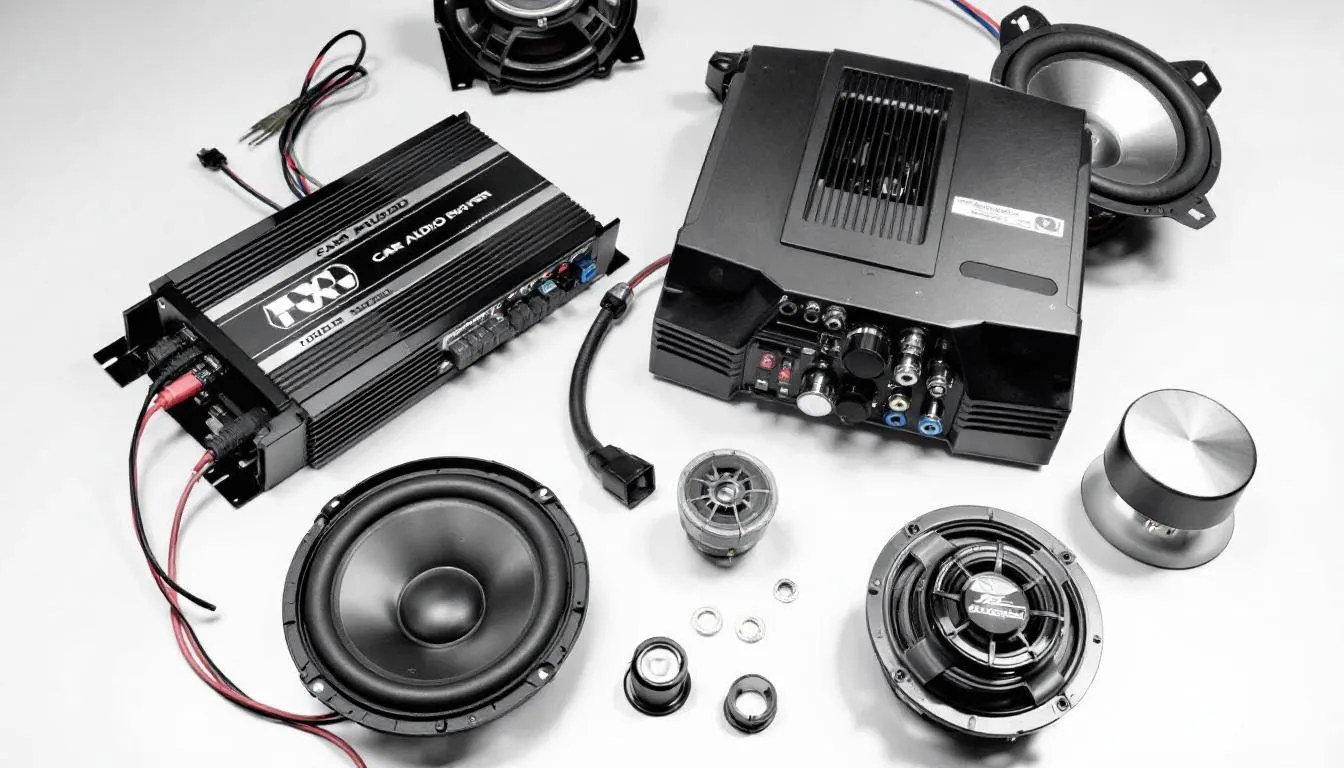
Subwoofers handle low-frequency reproduction that standard speakers cannot effectively produce, adding deep bass and powerful foundation to your music. Proper subwoofer integration requires careful consideration of enclosure design, amplifier matching, and cabin acoustics. Electric vehicles present unique challenges for subwoofer installation, as traditional trunk and underfloor locations are often occupied by high-voltage battery systems. Learn more about underseat subwoofer limitations.
Sound deadening materials and acoustic treatments address one of the biggest challenges in automotive audio: controlling unwanted noise and vibrations. These materials reduce road noise intrusion while preventing panel resonances that can muddy bass response. Professional installations often include strategic placement of sound deadening materials to create a quieter, more controlled acoustic environment that allows your audio system to perform at its best. It's important to consider the reach of these materials to ensure they cover all necessary areas for effective soundproofing throughout the vehicle.
Advanced Automotive Audio Technologies
The integration of advanced technologies has revolutionized automotive audio, transforming vehicles into connected entertainment hubs that rival home audio systems in both convenience and performance. These innovations focus on seamless connectivity, intelligent sound processing, and user-friendly interfaces that enhance safety while delivering exceptional audio experiences.
Wireless Apple CarPlay and Android Auto integration represents one of the most significant advances in automotive technology, eliminating the need for physical cables while providing full smartphone functionality through your vehicle’s display. This wireless connectivity maintains high-quality audio transmission while allowing passengers to charge their devices independently. The technology automatically connects when you enter your vehicle, providing immediate access to familiar apps and interfaces without disrupting your driving routine.
Bluetooth connectivity has evolved beyond basic audio streaming to include advanced codecs like aptX and LDAC that maintain near-CD quality over wireless connections. Modern implementations support multiple device pairing, allowing passengers to seamlessly share control of audio playback while maintaining separate phone connections for hands-free calling. Advanced Bluetooth systems also support metadata display, showing artist information, album artwork, and track details on your head unit display.
Digital Signal Processing (DSP) technology represents a quantum leap in automotive audio quality, using sophisticated algorithms to correct acoustic challenges inherent in vehicle cabins. DSP systems analyze your vehicle’s unique acoustic signature and apply real-time corrections for frequency response, time alignment, and phase coherence. This technology can transform even modest speaker systems into impressive audio experiences by compensating for poor speaker placement and cabin irregularities.
High-resolution audio support ensures your system can reproduce the full detail and dynamic range of modern recordings. Many premium automotive audio systems now support formats like FLAC, DSD, and high-bitrate streaming from services like Tidal and Qobuz. This capability becomes increasingly important as streaming services expand their high-quality offerings and more consumers invest in premium music subscriptions.
Voice control and AI assistant integration have made automotive audio systems more intuitive and safer to operate while driving. Modern systems respond to natural language commands, allowing you to adjust volume, change tracks, or switch between sources without taking your attention from the road. AI-powered features can learn your preferences and automatically adjust settings based on time of day, driving conditions, or passenger preferences.
Smartphone Integration Features
The seamless integration between smartphones and automotive audio systems has become essential for modern drivers who expect their mobile experience to continue uninterrupted in their vehicles. This integration goes far beyond simple audio playback, encompassing navigation, communication, and productivity features that enhance both convenience and safety.
Smartphone integration provides seamless app access that mirrors your mobile interface on your vehicle’s display, allowing familiar interaction with navigation apps like Google Maps or Waze, music streaming services, and productivity tools. This integration maintains consistent user experiences across devices while optimizing interfaces for in-vehicle use with larger buttons and simplified navigation suitable for brief glances while driving.
Music streaming from platforms like Spotify, Apple Music, Amazon Music, and Pandora operates seamlessly through integrated systems, providing access to millions of songs, personalized playlists, and recommendation algorithms. These services often include offline capabilities, downloading favorite playlists to your device for areas with poor cellular coverage. Integration with your vehicle’s steering wheel controls and voice commands makes playlist navigation safe and convenient.
Text messaging and call management capabilities ensure you stay connected while maintaining focus on driving. Advanced systems can read incoming messages aloud and allow voice-dictated responses, while sophisticated noise cancellation ensures clear hands-free calling even in challenging acoustic environments. Emergency features can automatically dial emergency services and provide location information if your vehicle’s safety systems detect a collision.
Navigation apps with real-time traffic updates integrate with your vehicle’s display and audio system, providing turn-by-turn directions through your speakers while displaying route information on your screen. These systems often integrate with your vehicle’s instrument cluster, showing relevant navigation information in your direct line of sight without requiring you to look away from the road.
Popular Automotive Audio Brands and Product Lines
The automotive audio market features several established manufacturers known for innovation, quality, and reliability. Understanding the strengths and specialties of major brands helps you choose components that meet your specific needs and budget while ensuring compatibility and long-term satisfaction. These brands not only manufacture but also sell a wide range of audio products and services, making it easy for consumers to access both new equipment and expert support.
Pioneer has established itself as a leader in automotive multimedia with their PRO Series representing the pinnacle of their engineering expertise. The PRO Series features advanced DSP processing, high-resolution audio support, and premium build quality designed for enthusiasts seeking audiophile-level performance. Their Z Series offers mainstream premium features including wireless smartphone integration, customizable interfaces, and robust amplification suitable for most upgrade scenarios. The A Series provides entry-level improvements over factory systems while maintaining Pioneer’s reputation for reliability and user-friendly operation, with models typically ranging from $300 to $800.
Alpine has built a reputation for premium audio systems and innovative multimedia receivers that emphasize both sound quality and advanced functionality. Their flagship systems feature partnerships with luxury vehicle manufacturers, bringing studio-quality audio reproduction to factory installations. Alpine’s aftermarket receivers include their renowned Halo series with floating displays and extensive customization options, while their speaker lines focus on accurate sound reproduction with minimal coloration. Pricing typically ranges from $400 to $1,500 for head units, with speaker systems ranging from $200 to $1,000 per pair.
Kenwood multimedia systems excel in providing comprehensive connectivity and user-friendly interfaces that appeal to tech-savvy consumers. Their eXcelon series represents their premium line with advanced audio processing, extensive smartphone integration, and high-quality construction. Kenwood’s speaker technologies include their Performance series, which focuses on delivering accurate sound reproduction with enhanced power handling capabilities. Their systems typically range from $250 to $1,200, offering strong value propositions in the mid-range market segment.
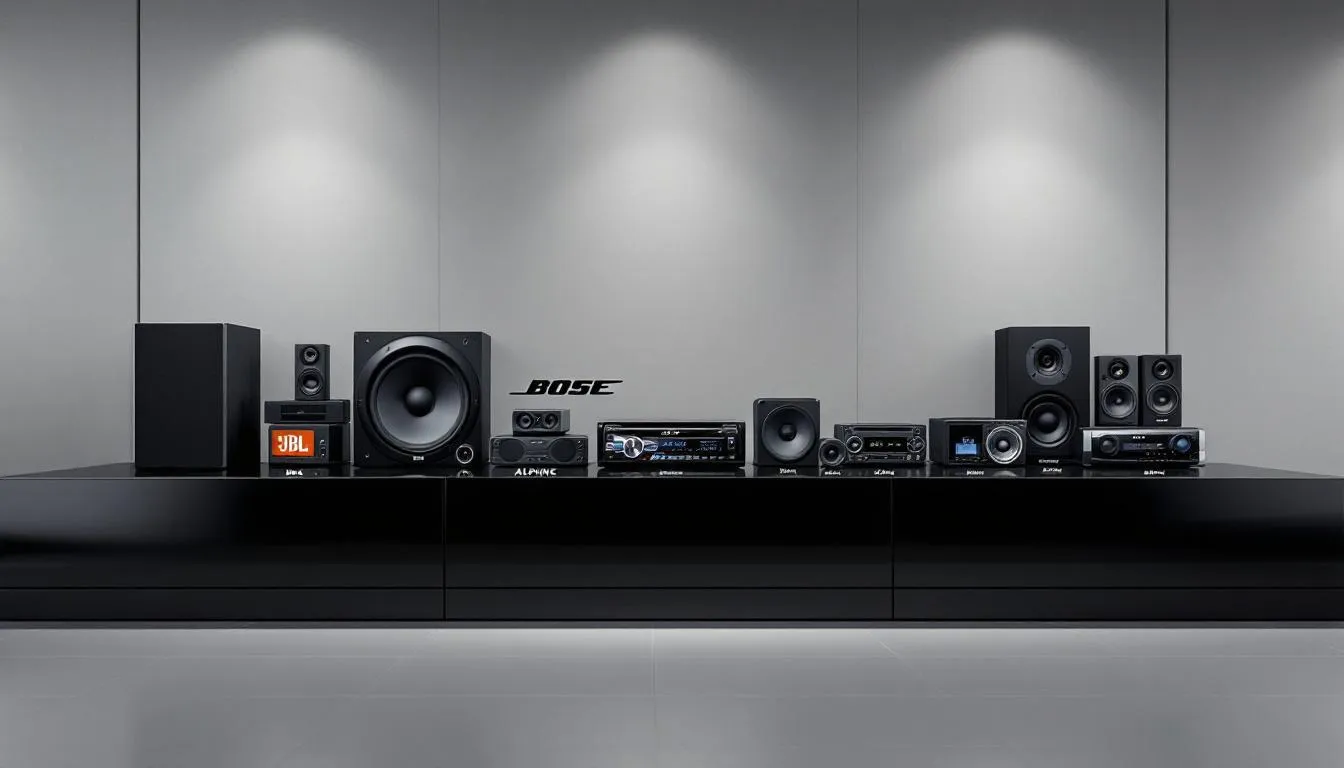
JL Audio has established itself as the premier manufacturer of subwoofers and amplification solutions, with their products setting standards for bass reproduction and build quality. Their W7 and W6v3 subwoofer series deliver exceptional deep bass with minimal distortion, while their amplifier lines provide clean, powerful amplification suitable for everything from modest upgrades to competition-level installations. JL Audio products command premium pricing, with subwoofers ranging from $300 to $1,500 and amplifiers from $400 to $2,000, but deliver performance that justifies the investment.
Sony XAV series and mobile entertainment systems focus on providing advanced multimedia features at competitive price points. Their systems emphasize smartphone integration, with many models offering both wired and wireless Apple CarPlay and Android Auto connectivity. Sony’s approach balances features and affordability, making advanced automotive audio accessible to a broader range of consumers. Their product lines typically range from $200 to $800, offering solid performance and extensive feature sets for budget-conscious upgraders.
Choosing the Right Car Audio System for Your Vehicle
Selecting the appropriate automotive audio system requires careful consideration of multiple factors including vehicle compatibility, budget constraints, performance expectations, and installation complexity. A systematic approach ensures you invest in components that deliver the performance you want while integrating seamlessly with your vehicle’s existing systems. When you buy the right audio equipment for your car, you ensure the best fit and performance for your needs.
Vehicle compatibility represents the most critical factor in system selection, as automotive audio components must physically fit your vehicle’s dashboard and door locations while integrating with existing electrical systems. Different vehicles use varying head unit sizes, speaker dimensions, and mounting methods that directly impact component selection. Modern vehicles with advanced factory systems may require specialized integration modules to maintain functionality of steering wheel controls, factory amplifiers, and vehicle information displays.
Budget planning requires balancing initial investment with long-term satisfaction, as automotive audio represents a significant upgrade that should provide years of enjoyment. Entry-level systems ranging from $500 to $1,500 can provide substantial improvements over factory audio while maintaining reasonable costs. Premium setups costing $2,000 to $5,000 or more deliver audiophile-level performance with advanced features and professional installation. Consider the total cost of ownership, including potential future upgrades and maintenance requirements.
Power requirements and electrical system compatibility ensure your chosen components operate safely within your vehicle’s electrical capacity. Modern vehicles with start-stop technology, advanced electronics, and hybrid or electric powertrains may have specific power management requirements that affect audio system design. Calculate total power consumption to ensure your vehicle’s charging system can support additional electrical loads without compromising reliability or fuel efficiency.
Space constraints and installation complexity factors vary significantly between vehicle models and can impact both component selection and total project costs. Compact vehicles may have limited space for amplifiers and subwoofers, requiring careful planning and possibly custom fabrication. Luxury vehicles with extensive factory features may require complex integration procedures that increase installation time and costs but preserve important vehicle functionality.
Matching your audio system to musical preferences and usage patterns ensures optimal satisfaction with your investment. Classical and acoustic music lovers may prioritize accurate midrange reproduction and detailed imaging, while electronic and hip-hop enthusiasts might focus on powerful bass response and high output capabilities. Consider your typical listening volumes, passenger requirements, and whether you prioritize absolute sound quality or convenience features like voice control and smartphone integration.
Screen Types and Display Options
The visual interface of your automotive audio system significantly impacts usability, safety, and overall satisfaction with your upgrade. Understanding the differences between display options helps you select a system that balances functionality with your vehicle’s interior design while providing intuitive operation.
Single DIN vs. Double DIN head unit sizes represent the fundamental choice in automotive audio displays, with each offering distinct advantages depending on your vehicle and preferences. Single DIN units measure approximately 2 inches tall by 7 inches wide, fitting older vehicles and providing basic functionality in a compact form factor. Double DIN units measure approximately 4 inches tall by 7 inches wide, accommodating larger displays and more comprehensive control interfaces but requiring compatible dashboard openings.
Touchscreen displays are available in 6.2”, 7”, 8”, and 9” configurations, with larger screens providing better visibility and more intuitive operation at the cost of increased complexity and higher prices. 6.2” displays represent the minimum size for comfortable touchscreen operation, suitable for basic multimedia functions and smartphone integration. 7” and 8” displays offer enhanced usability with larger buttons and more detailed information display, while 9” screens provide tablet-like experiences with extensive customization options and multiple information zones.
Resolution differences and display quality considerations affect both daytime visibility and nighttime use, with higher-resolution displays providing sharper text and more detailed graphics. Modern displays feature anti-glare coatings and automatic brightness adjustment to maintain visibility in varying lighting conditions. Color accuracy and viewing angles become important factors for displays that will be viewed from multiple seating positions or in bright sunlight conditions.
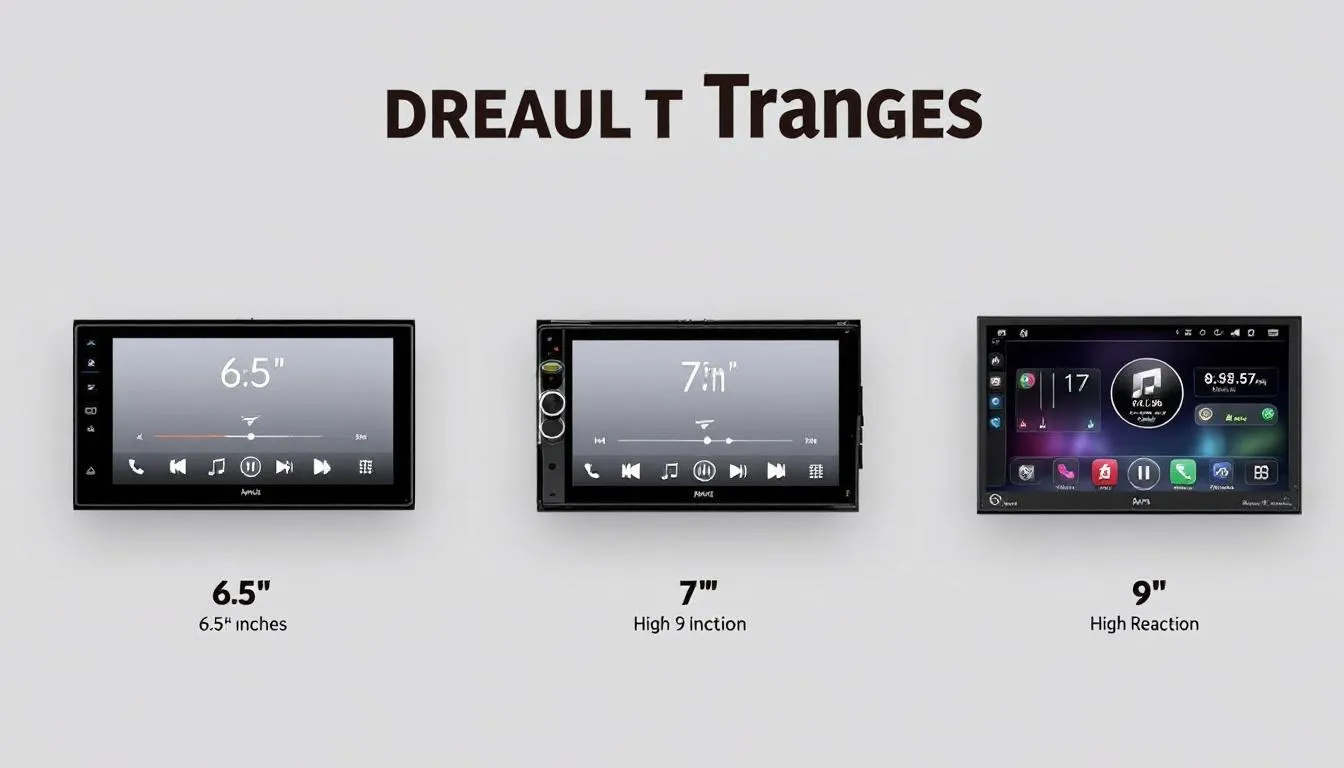
Floating vs. integrated display designs impact both aesthetics and functionality, with each approach offering distinct advantages. Floating displays project from the dashboard, providing better viewing angles and easier operation but may appear less integrated with your vehicle’s interior design. Integrated displays fit flush with dashboard trim, maintaining factory appearance but may be positioned less optimally for viewing and operation. Consider your vehicle’s interior design and personal preferences when selecting between these approaches.
Vehicle type recommendations vary based on dashboard space, interior design, and typical usage patterns. Compact cars often benefit from 6.2” to 7” displays that provide adequate functionality without overwhelming the interior space. Mid-size vehicles can accommodate 7” to 8” displays that balance functionality with proportional appearance. Large vehicles and trucks can effectively utilize 8” to 9” displays that provide commanding visibility and comprehensive feature access appropriate for their scale and functionality requirements.
Professional Installation vs. DIY Setup
The decision between professional installation and DIY setup significantly impacts both the immediate cost and long-term satisfaction with your automotive audio upgrade. Understanding the complexity, requirements, and potential outcomes of each approach helps you make the best choice for your specific situation and skill level.
Professional installation services provide expertise, specialized tools, and warranty protection that ensure optimal performance and reliability from your audio system. Additionally, building a fitment sheet or database during professional installation helps track compatibility and installation success, improving future recommendations and ensuring accurate fitment. Experienced installers understand vehicle-specific integration requirements, proper wiring techniques, and acoustic optimization that maximize system performance. Professional installation typically includes custom fabrication, sound deadening application, and system tuning that achieves results difficult to replicate in DIY installations.
Complex wiring and integration requirements in modern vehicles often necessitate professional expertise to maintain functionality while adding aftermarket components. Advanced vehicles with CAN bus communication, factory amplifiers, and integrated controls require specialized knowledge to preserve features like steering wheel controls, voice commands, and vehicle information displays. Professional installers have access to vehicle-specific harnesses, bypass modules, and integration tools that ensure seamless operation.
Warranty considerations play a crucial role in installation decisions, as professional installation often includes workmanship guarantees and may be required to maintain manufacturer warranties on expensive components. Professional installers carry insurance and stand behind their work, providing recourse if problems develop. Many component manufacturers offer extended warranties or enhanced coverage for professionally installed systems, recognizing the importance of proper installation techniques.
DIY installation challenges include access to specialized tools, vehicle disassembly procedures, and technical knowledge required for proper integration. Modern vehicles often require extensive disassembly to access speaker locations and routing paths for wiring, with procedures that can be time-consuming and potentially damaging if performed incorrectly. Integration with factory systems may require research, specialized adapters, and troubleshooting skills that exceed typical DIY capabilities.
Cost comparison between professional and self-installation varies significantly based on system complexity and local labor rates. Professional installation typically costs $200 to $500 for basic systems and $500 to $1,500 for complex installations with multiple amplifiers, custom fabrication, and extensive integration requirements. DIY installation saves labor costs but may require tool purchases and additional time investment that should be factored into total project costs.
Timeline estimates for professional installation range from one day for basic head unit and speaker upgrades to several days for comprehensive systems with custom fabrication and extensive sound deadening. DIY installations typically require more time due to learning curves and limited access to specialized tools, with basic installations taking weekends and complex projects potentially requiring weeks of part-time effort. Consider your available time and patience when choosing between approaches.
Sound System Optimization and Tuning
Proper optimization and tuning transform good automotive audio components into exceptional sound systems that deliver their full potential. Many people seek advice or share their experiences when tuning their car audio systems, as questions about achieving the best sound are common among enthusiasts. This process requires attention to acoustic principles, careful adjustment of electronic settings, and systematic evaluation of results to achieve balanced, natural sound reproduction.
EQ settings and frequency response tuning address the acoustic challenges inherent in vehicle cabins, which typically emphasize certain frequencies while attenuating others due to their irregular shapes and hard surfaces. Modern automotive audio systems include parametric equalizers that allow precise adjustment of specific frequency bands to compensate for cabin resonances and speaker placement compromises. Start with subtle adjustments, boosting or cutting frequencies by no more than 3-6 dB initially, and make changes while listening to familiar music at moderate volumes.
Sound deadening installation significantly improves acoustic performance by reducing noise intrusion and controlling unwanted resonances that can muddy bass response and interfere with midrange clarity. Strategic placement of sound deadening materials on door panels, floor areas, and trunk surfaces creates a more controlled acoustic environment that allows your audio system to perform at its best. Focus on areas where you can feel vibrations during music playback, as these locations contribute most significantly to acoustic problems.
Speaker placement and positioning optimization maximizes imaging and soundstage width, creating more realistic and engaging listening experiences. Tweeters should be positioned at ear level and angled toward the listening position when possible, while midrange drivers benefit from locations that minimize reflections from glass and hard surfaces. Time alignment features in advanced systems compensate for different distances between speakers and listeners, creating more coherent sound reproduction.
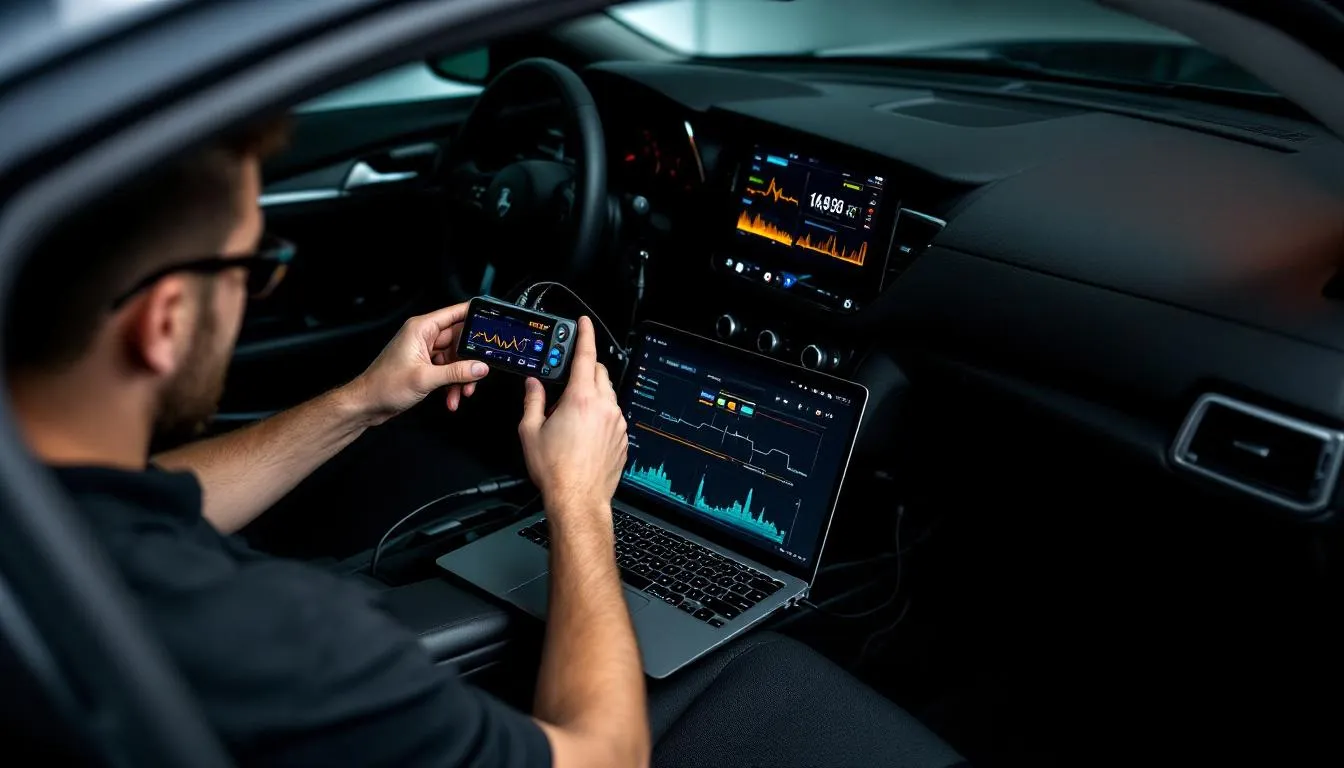
Amplifier gain setting and power distribution ensure optimal performance while protecting components from damage due to overpowering or distortion. Set gains using a systematic approach with test tones or familiar music at moderate volumes, gradually increasing gain until you achieve desired output levels without audible distortion. Proper gain setting maximizes signal-to-noise ratio while preventing amplifier clipping that can damage speakers and degrade sound quality.
Time alignment and phase correction techniques create more cohesive sound reproduction by ensuring that sound waves from different speakers arrive at your ears simultaneously and in proper phase relationship. Digital signal processors can apply precise time delays to individual speakers, compensating for varying distances and creating more realistic soundstage imaging. Phase adjustment ensures that drivers work together rather than canceling each other’s output, particularly important for subwoofer integration with main speakers.
Step-by-step tuning guidelines begin with setting proper levels and gains, then proceed to frequency response correction, time alignment, and finally fine-tuning based on personal preferences. Use familiar music with good dynamic range and avoid making adjustments at high volume levels that can damage hearing and mask subtle details. Document your settings and make small changes systematically, evaluating each adjustment before proceeding to the next parameter.
Latest Trends in Automotive Audio Technology
The automotive audio industry continues to evolve rapidly, driven by advances in digital processing, connectivity standards, and changing consumer expectations. Understanding current trends helps you select systems that will remain relevant and provide long-term satisfaction as technology continues to advance.
OEM integration with factory systems and steering wheel controls has become increasingly sophisticated, with aftermarket manufacturers developing solutions that preserve advanced vehicle features while upgrading audio performance. Modern integration modules maintain functionality of voice commands, vehicle information displays, and advanced driver assistance systems that depend on audio feedback. This trend reflects consumer demand for upgrades that enhance rather than compromise their vehicle’s existing capabilities.
Electric vehicle audio considerations present unique challenges and opportunities as automakers transition to electrified powertrains. The absence of engine noise in electric vehicles allows audio systems to operate in quieter environments, potentially improving perceived sound quality while requiring careful consideration of power consumption that can impact driving range. Manufacturers are developing more efficient amplifiers and processing systems specifically designed for electric vehicle applications.
Wireless audio transmission and battery-powered components represent emerging solutions to installation challenges in modern vehicles with complex electrical systems and limited space for traditional wiring. Wireless subwoofers and satellite speakers eliminate the need for extensive cable runs while providing placement flexibility. Battery-powered amplifiers can operate independently of vehicle electrical systems, reducing load on hybrid and electric vehicle charging systems.
AI-powered sound enhancement and automatic tuning systems use machine learning algorithms to optimize audio performance based on cabin acoustics, music content, and user preferences. These systems can automatically adjust EQ settings, time alignment, and dynamic range processing to optimize performance for different types of music or listening conditions. Advanced implementations learn from user adjustments and preferences, gradually improving performance over time.
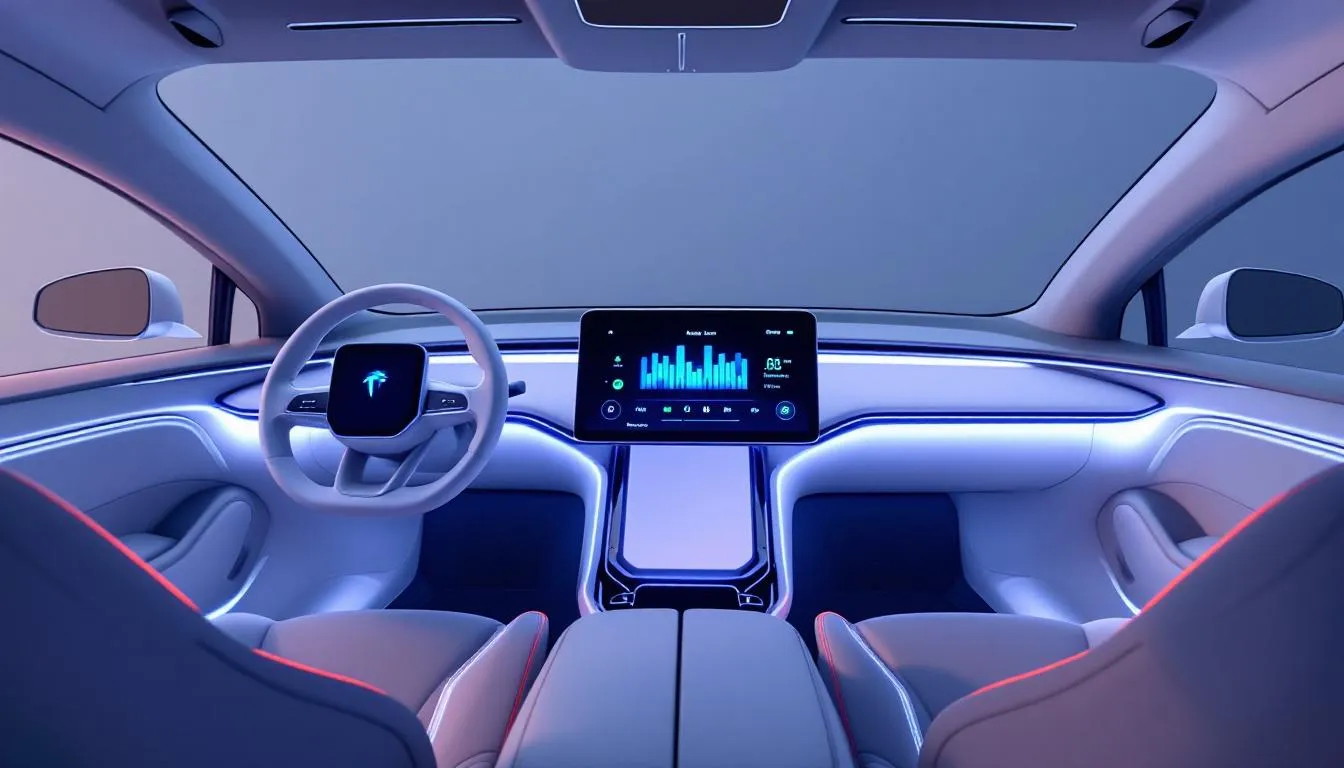
Future developments in automotive audio technology include acoustic holography for creating virtual speakers in arbitrary cabin locations, augmented reality audio overlays for navigation and safety information, and cross-device audio continuity that seamlessly transfers music between home, mobile, and vehicle environments. Immersive audio standards like Dolby Atmos are becoming more common in premium vehicles, creating three-dimensional soundscapes that enhance both entertainment and safety through spatial audio cues.
Specific examples from 2024 model year vehicles demonstrate these trends in action. The GMC Hummer EV features Bose sound enhancement that synthesizes electric motor sounds through cabin speakers, addressing customer expectations for audible feedback. Mercedes-Benz vehicles now offer Burmester 4D surround sound systems with over 30 speakers and seat-integrated transducers that provide tactile bass response. BMW’s latest models include gesture control for audio functions and AI-powered music recommendation systems that learn driver preferences and suggest playlists based on journey context and time of day.
Conclusion
The transformation of automotive audio from basic AM/FM radios to sophisticated multimedia entertainment centers reflects our evolving relationship with our vehicles as spaces for both transportation and personal expression. Modern automotive audio systems offer unprecedented opportunities to enhance your driving experience through superior sound quality, seamless connectivity, and intelligent features that prioritize both entertainment and safety.
Whether you choose to upgrade individual components or invest in a comprehensive system overhaul, the key to success lies in understanding your specific needs, vehicle requirements, and long-term goals. The automotive audio market offers solutions for every budget and preference, from entry-level improvements that dramatically enhance factory systems to audiophile-grade installations that rival high-end home audio setups.
As the industry continues to evolve with electric vehicles, AI integration, and immersive audio technologies, the investment you make in quality automotive audio components today will provide years of enhanced driving enjoyment. The combination of improved sound quality, advanced connectivity, and intelligent features transforms every journey into an opportunity for entertainment, productivity, and connection.
Take time to evaluate your current system, identify areas for improvement, and explore the options that best match your preferences and budget. Whether you choose professional installation or tackle the project yourself, upgrading your vehicle’s audio system represents one of the most impactful modifications you can make to enhance your daily driving experience.
Car Audio Accessories
Car audio accessories are the key to unlocking the full potential of your vehicle’s sound system. Whether you’re seeking deep bass, crystal-clear highs, or a more immersive music experience, the right accessories can make all the difference. From powerful subwoofers and high-performance amplifiers to precision-engineered speakers, each component is designed to enhance your car’s audio system and deliver superior performance on every drive. A well-chosen setup not only produces quality sound but also transforms your daily commute or road trip into a concert-like journey. At our shop, we offer a wide variety of car audio accessories from top brands, ensuring you find the perfect products to upgrade your system. Our selection is engineered to meet diverse needs, so whether you want to add powerful bass or simply improve overall sound quality, we have the gear to help you enhance and transform your vehicle’s audio experience.
Car Audio Safety Features
Safety is just as important as sound quality when it comes to your car audio system. Modern car audio safety features are designed to keep you focused on the road while still enjoying all the benefits of a high-performance setup. Features like backup cameras, Bluetooth connectivity, and voice command systems are engineered to reduce distractions and make every journey safer. Our team is dedicated to providing the latest safety-focused products and services, from seamless integration of hands-free controls to advanced system setups that enhance both convenience and peace of mind. We offer a range of solutions designed to improve your driving experience and ensure your audio system supports safe habits behind the wheel. Trust our expertise to help you choose and install the right safety features for your vehicle, so you can enjoy superior sound and stay protected on every drive.
Car Audio System Customization
Customizing your car audio system is the ultimate way to create a sound experience that’s uniquely yours. Our team of experts brings a passion for quality and performance to every project, working closely with you to design a system that matches your preferences and lifestyle. From selecting the right products to crafting a setup that produces exceptional sound, we use the latest tools and our deep expertise to deliver results that exceed expectations. Whether you’re an audiophile seeking the perfect listening environment or simply want to upgrade your vehicle’s audio system, our commitment to excellence ensures your system is built to your exact needs. Our customization services cover everything from system design and product selection to professional installation, all tailored to your car and your vision. Let us help you create a car audio system that stands out for its quality, performance, and personal touch.
Car Audio System Budgeting
Upgrading your car audio system doesn’t have to be overwhelming or expensive. Smart budgeting is essential to getting the best sound and performance for your investment. Our team is here to guide you through the process, offering expert advice on how to allocate your budget for maximum impact. We provide a wide range of products and services at various price points, all designed to deliver superior sound and system performance. Whether you’re looking for a simple upgrade or a complete overhaul, we can help you create a car audio system that meets your needs and fits your budget. Our approach is focused on providing value, ensuring you get the most out of every dollar spent. Let us help you find the right balance between quality, features, and cost, so you can enjoy an upgraded audio experience without compromise.
Vehicle’s Audio System Maintenance
Keeping your vehicle’s audio system in top condition is essential for maintaining quality sound and reliable performance. Regular maintenance not only preserves the life of your equipment but also ensures your car audio system continues to deliver the experience you expect. Our team offers a comprehensive range of services, including system checks, software updates, and professional cleaning, all designed to keep your setup running smoothly. We also provide expert advice on caring for your system, from avoiding common pitfalls to optimizing performance with the right tools and techniques. Whether you need to fix an issue, improve sound quality, or simply keep your audio system in good working order, our expertise and commitment to service mean you can trust us to provide the support you need. Rely on our team to help you maintain and enhance your car audio system for years of superior sound and enjoyment.

